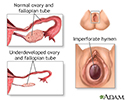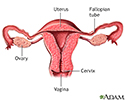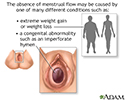Absent menstrual periods - primary
Primary amenorrhea; No periods - primary; Absent periods - primary; Absent menses - primary; Absence of periods - primaryAbsence of a woman's monthly menstrual period is called amenorrhea.
Primary amenorrhea is when a girl has not yet started her monthly periods, and she:
- Has gone through other normal changes that occur during puberty
- Is older than 15
Causes
Most girls begin their periods between ages 9 and 18. The average is around 12 years old. If no periods have occurred when a girl is older than 15, further testing may be needed. The need is more urgent if she has gone through other normal changes that occur during puberty.
Being born with incompletely formed genital or pelvic organs can lead to a lack of menstrual periods. Some of these defects include:
- Blockages or narrowing of the cervix
-
Hymen that has no opening
Hymen
Developmental differences of the female reproductive tract affect the reproductive organs of a female infant. They occur while the baby is growing i...
 ImageRead Article Now Book Mark Article
ImageRead Article Now Book Mark Article - Missing uterus or vagina
- Vaginal septum (a wall that divides the vagina into 2 sections)
Hormones play a big role in a woman's menstrual cycle. Hormone problems can occur when:
- Changes occur to the parts of the brain where hormones that help manage the menstrual cycle are produced.
- The ovaries are not working correctly.
Either of these problems may be due to:
-
Anorexia (loss of appetite) with low body mass index (BMI)
Anorexia
Anorexia is an eating disorder that causes people to weigh less than is considered healthy for their age and height, usually by excessive weight loss...
 ImageRead Article Now Book Mark Article
ImageRead Article Now Book Mark Article - Chronic or long-term illnesses, such as cystic fibrosis or heart disease
Cystic fibrosis
Cystic fibrosis is a disease that causes thick, sticky mucus to build up in the lungs, digestive tract, and other areas of the body. It is one of th...
 ImageRead Article Now Book Mark Article
ImageRead Article Now Book Mark Article - Genetic defects or disorders
- Infections that occurred before or after the woman's birth
- Other birth defects
- Poor nutrition
- Tumors
In many cases, the cause of primary amenorrhea is not known.
Symptoms
A female with amenorrhea will have no menstrual flow. She may have other signs of puberty.
Exams and Tests
The health care provider will perform a physical exam to check for birth defects of the vagina or uterus.
The provider will ask questions about:
- Your medical history
- Medicines and supplements you may be taking
- How much exercise you do
- Your eating habits
A pregnancy test will be done.
Blood tests to measure different hormone levels may include:
-
Estradiol
Estradiol
An estradiol test measures the amount of a hormone called estradiol in the blood. Estradiol is one of the main types of estrogens.
 ImageRead Article Now Book Mark Article
ImageRead Article Now Book Mark Article -
Follicle stimulating hormone (FSH)
Follicle stimulating hormone
The follicle stimulating hormone (FSH) blood test measures the level of FSH in blood. FSH is a hormone released by the pituitary gland, located on t...
Read Article Now Book Mark Article -
Luteinizing hormone (LH)
Luteinizing hormone
The LH blood test measures the amount of luteinizing hormone (LH) in blood. LH is a hormone released by the pituitary gland, located on the undersid...
Read Article Now Book Mark Article -
Prolactin
Prolactin
Prolactin is a hormone released by the pituitary gland. The prolactin blood test measures the amount of prolactin in the blood.
 ImageRead Article Now Book Mark Article
ImageRead Article Now Book Mark Article -
17 hydroxyprogesterone
17 hydroxyprogesterone
17-OH progesterone is a blood test that measures the amount of 17-OH progesterone in the blood. This is a hormone produced by the adrenal glands and...
 ImageRead Article Now Book Mark Article
ImageRead Article Now Book Mark Article -
Serum progesterone
Serum progesterone
Serum progesterone is a test to measure the amount of progesterone in the blood. Progesterone is a hormone produced mainly in the ovaries. Progester...
Read Article Now Book Mark Article - Serum testosterone level
-
Thyroid stimulating hormone (TSH)
Thyroid stimulating hormone
A TSH test measures the amount of thyroid stimulating hormone (TSH) in your blood. TSH is produced by the pituitary gland. It prompts the thyroid g...
 ImageRead Article Now Book Mark Article
ImageRead Article Now Book Mark Article -
T3 and T4
T3
Triiodothyronine (T3) is a thyroid hormone. It plays an important role in the body's control of metabolism (the many processes that control the rate...
 ImageRead Article Now Book Mark Article
ImageRead Article Now Book Mark ArticleT4
T4 (thyroxine) is the main hormone produced by the thyroid gland. A laboratory test can be done to measure the amount of free T4 in your blood. Fre...
 ImageRead Article Now Book Mark Article
ImageRead Article Now Book Mark Article
Other tests that may be done include:
-
Chromosome or genetic testing
Chromosome or genetic testing
Karyotyping is a test to examine chromosomes in a sample of cells. This test can help identify genetic problems as the cause of a disorder or diseas...
 ImageRead Article Now Book Mark Article
ImageRead Article Now Book Mark Article -
Head CT scan or head MRI scan to look for brain tumors
Head CT scan
A head computed tomography (CT) scan uses many x-rays to create pictures of the head, including the skull, brain, eye sockets, and sinuses.
 ImageRead Article Now Book Mark Article
ImageRead Article Now Book Mark ArticleHead MRI scan
A head MRI (magnetic resonance imaging) is an imaging test that uses powerful magnets and radio waves to create pictures of the brain and surrounding...
 ImageRead Article Now Book Mark Article
ImageRead Article Now Book Mark Article - Pelvic ultrasound or MRI to look for birth defects
Treatment
Treatment depends on the cause of the missing period. Lack of periods that is caused by birth defects may require hormone medicines, surgery, or both.
If the amenorrhea is caused by a tumor in the brain:
- Medicines may shrink certain types of tumors.
- Surgery to remove the tumor may also be needed.
-
Radiation therapy is usually only done when other treatments have not worked.
Radiation therapy
Radiation therapy uses high-powered radiation (such as x-rays or gamma rays), particles, or radioactive seeds to kill cancer cells.
 ImageRead Article Now Book Mark Article
ImageRead Article Now Book Mark Article
If the problem is caused by a systemic disease, treatment of the disease may allow menstruation to begin.
If the cause is bulimia, anorexia or too much exercise, periods will often begin when the weight returns to normal or the exercise level is decreased.
Bulimia
Bulimia is an eating disorder in which a person has regular episodes of eating a very large amount of food (bingeing) during which the person feels a...

If the amenorrhea cannot be corrected, hormone medicines can sometimes be used. Medicines can help the woman feel more like her friends and female family members. They can also protect the bones from becoming too thin (osteoporosis).
Osteoporosis
Osteoporosis is a disease in which bones become fragile and more likely to break (fracture).

Outlook (Prognosis)
The outlook depends on the cause of the amenorrhea and whether it can be corrected with treatment or lifestyle changes.
Periods are not likely to start on their own if the amenorrhea was caused by one of the following conditions:
- Birth defects of the female organs
-
Craniopharyngioma (a tumor near the pituitary gland at the base of the brain)
Craniopharyngioma
A craniopharyngioma is a noncancerous (benign) tumor that develops at the base of the brain near the pituitary gland.
 ImageRead Article Now Book Mark Article
ImageRead Article Now Book Mark Article - Cystic fibrosis
- Genetic disorders
You may have emotional distress because you feel different from friends or family. Or, you may worry that you might not be able to have children.
When to Contact a Medical Professional
Contact your provider if your daughter is older than 15 and has not yet begun menstruating, or if she is 14 or older and shows no other signs of puberty.
References
Bulun SE. Physiology and pathology of the female reproductive axis. In: Melmed S, Auchus RJ, Goldfine AB, Koenig RJ, Rosen CJ, eds. Williams Textbook of Endocrinology. 14th ed. Philadelphia, PA: Elsevier; 2020:chap 17.
Cameron S. Menstruation and amenorrhoea. In: Magowan B, ed. Clinical Obstetrics and Gynaecology. 5th ed. Elsevier; 2023:chap 4.
Lobo RA. Primary and secondary amenorrhea and precocious puberty: etiology, diagnostic evaluation, management. In: Gershenson DM, Lentz GM, Valea FA, Lobo RA, eds. Comprehensive Gynecology. 8th ed. Philadelphia, PA: Elsevier; 2022:chap 36.
-
Primary amenorrhea - illustration
Primary amenorrhea is the absence of the menstrual period by the age of 16. Treatment of amenorrhea may range from hormonal supplementation for developmental abnormalities of the reproductive system to surgery for tumors of the pituitary.
Primary amenorrhea
illustration
-
Normal uterine anatomy (cut section) - illustration
The uterus is a muscular organ with thick walls, two upper openings to the fallopian tubes and an inferior opening to the vagina.
Normal uterine anatomy (cut section)
illustration
-
Absence of menstruation (amenorrhea) - illustration
Amenorrhea is the lack of menstrual flow and can be a normal occurrence or a sign of malfunction or disease. In primary amenorrhea, menstruation does not begin when expected (by the age of 16). Secondary amenorrhea occurs when the normal established menstrual cycle is shut down for 6 or more months due to a condition other than pregnancy, breastfeeding or menopause.
Absence of menstruation (amenorrhea)
illustration
-
Primary amenorrhea - illustration
Primary amenorrhea is the absence of the menstrual period by the age of 16. Treatment of amenorrhea may range from hormonal supplementation for developmental abnormalities of the reproductive system to surgery for tumors of the pituitary.
Primary amenorrhea
illustration
-
Normal uterine anatomy (cut section) - illustration
The uterus is a muscular organ with thick walls, two upper openings to the fallopian tubes and an inferior opening to the vagina.
Normal uterine anatomy (cut section)
illustration
-
Absence of menstruation (amenorrhea) - illustration
Amenorrhea is the lack of menstrual flow and can be a normal occurrence or a sign of malfunction or disease. In primary amenorrhea, menstruation does not begin when expected (by the age of 16). Secondary amenorrhea occurs when the normal established menstrual cycle is shut down for 6 or more months due to a condition other than pregnancy, breastfeeding or menopause.
Absence of menstruation (amenorrhea)
illustration
-
Menstrual disorders - InDepth
(In-Depth)
-
Premenstrual syndrome - InDepth
(In-Depth)
-
Anorexia nervosa
(Alt. Medicine)
-
Infertility in women - InDepth
(In-Depth)
-
Narcolepsy - InDepth
(In-Depth)
-
Alcohol use disorders - InDepth
(In-Depth)
-
Eating disorders - InDepth
(In-Depth)
Review Date: 4/16/2024
Reviewed By: John D. Jacobson, MD, Professor Emeritus, Department of Obstetrics and Gynecology, Loma Linda University School of Medicine, Loma Linda, CA. Also reviewed by David C. Dugdale, MD, Medical Director, Brenda Conaway, Editorial Director, and the A.D.A.M. Editorial team.





